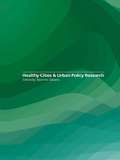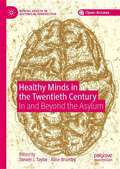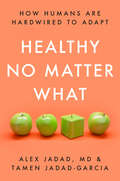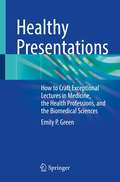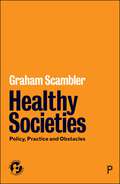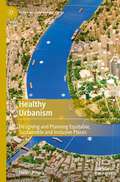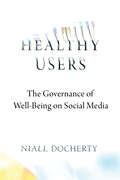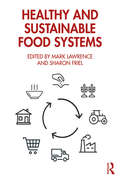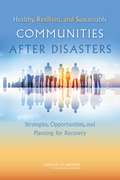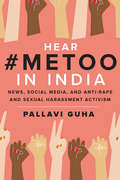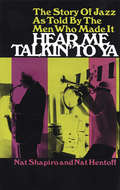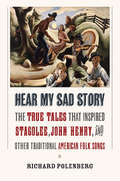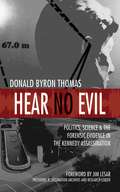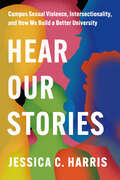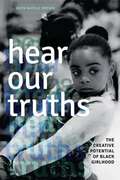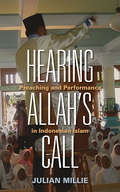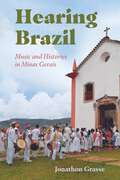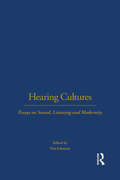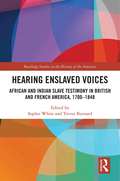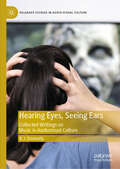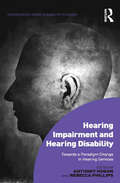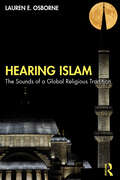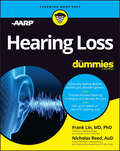- Table View
- List View
Healthy Chest Binding for Trans and Non-Binary People: A Practical Guide
by Frances ReedBinding is a crucial strategy in many transgender and non-binary people's lives for coping with gender dysphoria, yet the vast majority of those who bind report some negative physical symptoms. Written by Frances Reed, a licensed bodywork and massage therapist specialising in gender transition, this comprehensive guide helps you make the healthiest choices from the very start of your binding journey.Including guidance for choosing the right binder, approaching your first bind, an overview of potential health risks and complications, a range of self-massage and self-fascial release exercises to minimize pain and dysphoria, as well as tips and tricks for exercising safely in a binder - this is the ultimate resource for anyone that practices chest binding.
Healthy Cities and Urban Policy Research
by Takehito TakanoHealthy Cites and Urban Policy Research is a collection of papers by leading experts from academia or international organisations who have been involved in the Healthy Cities Movement. It is the first academic work to combine public health with urban planning. Contemporary issues from various perspectives are included which address evaluation, evidence-based practice, accountability, community participation and information technology.
Healthy Democracies: Welfare Politics in Taiwan and South Korea
by Joseph WongDo the pressures of economic globalization undermine the welfare state? Contrary to the expectations of many analysts, Taiwan and South Korea have embarked on a new trajectory, toward a strengthened welfare state and universal inclusion. In Healthy Democracies, Joseph Wong offers a political explanation for health care reform in these two countries. He focuses specifically on the ways in which democratic change in Taiwan and South Korea altered the incentives and ultimately the decisions of policymakers and social policy activists in contemporary health care debates. Wong uses extensive field research and interviews to explore both similarities and subtle differences in the processes of political change and healthcare reform in Taiwan and South Korea. During the period of authoritarian rule, he argues, state leaders in both places could politically afford to pursue selective social policies--reform was piecemeal and health care policy outcomes far from universal. Wong finds that the introduction of democratic reform changed the political logic of social policy reform: vote-seeking politicians needed to promote popular policies, and health care reform advocates, from bureaucrats to grassroots activists, adapted to this new political context. In Wong's view, the politics of democratic transition in Taiwan and South Korea has served as an effective antidote to the presumed economic imperatives of social welfare retrenchment during the process of globalization.
Healthy Minds in the Twentieth Century: In and Beyond the Asylum (Mental Health in Historical Perspective)
by Steven J. Taylor Alice BrumbyThis open access edited collection contributes a new dimension to the study of mental health and psychiatry in the twentieth century. It takes the present literature beyond the ‘asylum and after’ paradigm to explore the multitude of spaces that have been permeated by concerns about mental well-being and illness. The chapters in this volume consciously attempt to break down institutional walls and consider mental health through the lenses of institutions, policy, nomenclature, art, lived experience, and popular culture. The book adopts an international scope covering the historical experiences of Britain, Ireland, and North America. In accordance with this broad approach, contributions to the volume span academic fields such as history, arts, literary studies, sociology, and psychology, mirroring the diversity of the subject matter. This book is available open access under a CC BY 4.0 license at link.springer.com
Healthy No Matter What: How Humans Are Hardwired to Adapt
by Alex Jadad Tamen Jadad-GarciaA provocative manifesto that teaches you how to take control of your own health, no matter your age or circumstances—from an innovative doctor and his philosopher daughter&“If you care about your health or the well-being of others, read this book.&”—Ethan Kross, author of ChatterDr. Alex Jadad is the creator of the Jadad scale, which has become the world&’s most widely used methodology to assess the quality of clinical trials, and his daughter Tamen Jadad-Garcia is a health entrepreneur and philosopher. Here they combine their expertise to uncover the medical system&’s unstable foundations, which condemn you to be ill. The Jadads begin this exploration with a simple question: &“What is health?&”Through engaging stories and case studies, the Jadads expand the understanding of health beyond the medical industrial complex. They show how distant connections in your personal networks can influence key aspects of yourself, like your weight, anxiety, and addictions; how reliance on medications can be reduced by intentionally designing the places where you live, work, and play; and how comparisons with peers can shorten your life.In this practical guide, the meaning of health is redefined, putting you in the driver&’s seat and recognizing you as the most effective evaluator. Building on data and experiences from millions of people around the world, the book reveals that a healthy life is possible even with complex chronic conditions or terminal illnesses. The Jadads explain why perceiving yourself as unhealthy might actually be fatal, and how you can monitor your true health and boost it in practically any context, no matter your cultural background or socioeconomic circumstances.With wisdom and empathy, Healthy No Matter What teaches you how your natural gift of adaptability equips you to overcome any obstacle, provides actionable pointers, and shows how and when to use the medical system, so that you can thrive, regardless of the twists and turns life may take.
Healthy Presentations: How to Craft Exceptional Lectures in Medicine, the Health Professions, and the Biomedical Sciences
by Emily P. GreenThis book is a practical guide for busy clinicians and educators within the biomedical sciences on how to improve their presentations. It includes specific, practical guidance on crafting a talk, tips on incorporating interactive elements to facilitate active learning, and before-and-after examples of improved slide design. Chapters discuss all aspects of exceptional presentations such as the identification of main concepts, organization of content, and best practices for creating lectures that are focused on the facilitation of learning rather than on passive information transfer. The examples provided are grounded in the biomedical sciences where presentations are necessarily dense and rich with critical content, making this book an essential read for anyone who lectures within a biomedical curriculum or presents at professional conferences. This book also addresses hot topics in medical education such as presenting on virtual platforms, and reviewing teaching materials for diversity, inclusion, and bias. These topics are not addressed in any other books on the market, and they address real gaps in medical and health professions training. Written from the perspective of an educator with over 20 years of experience in medical education, Healthy Presentations: How to Craft Exceptional Lectures in Medicine, the Health Professions, and the Biomedical Sciences recognizes the importance of high-quality, inclusive, and learner-centered presentations, and it provides essential guidance and support to the faculty who create them.
Healthy Societies: Policy, Practice and Obstacles (21st Century Standpoints)
by Graham ScamblerCan society be healthy, and how? Is Britain a ‘healthy society’ in the 21st century? When people ponder health, they usually consider the health of the individual, but individuals co-exist in a social environment so attention should be placed on the health of communities and populations. Re-examining health, healthcare and societal health using the latest data and research, this book provides a clear, accessible account of the current state of play. Addressing definitions of health in individuals, communities and populations, definitions of society itself, changes in health over time and the contribution of healthcare to health and longevity, it also suggests ways of effectively tackling obstacles to improving health and healthcare in 21st century Britain.
Healthy Urbanism: Designing and Planning Equitable, Sustainable and Inclusive Places (Planning, Environment, Cities)
by Helen PineoThe globally distributed health impacts of environmental degradation and widening inequalities require a fundamental shift in understandings of healthy urbanism. This book redefines the meaning and form of healthy urban environments, urging planners and design professionals to consider how their work impacts population health and wellbeing at multiple spatial and temporal scales. The concepts of equity, inclusion and sustainability are central to this framing, reversing the traditional focus on individuals, their genes and ‘lifestyle choices’ to one of structural factors that affect health. Integrating theory and concepts from social epidemiology, sustainable development and systems thinking with practical case studies, this book will be of value for students and practitioners.
Healthy Users: The Governance of Well-Being on Social Media
by Niall DochertyWe are often told that social media well-being is simply the result of individual users making healthy digital choices. All it takes is a little self-discipline. In this book, Niall Docherty looks closely at this belief and exposes the complex relations of power expressed through its articulation and enactment. Docherty creatively and empirically shows how the discourses, designs, and habits of online well-being push user conduct in certain directions, at the expense of others. This is a contingent mode of governance that combines logics of neoliberalism, practices of psychologized person-making, and persuasive capitalist interfaces. By highlighting the damaging effects of this current arrangement, Healthy Users charts a path that will change how we understand and study social media well-being in the future.
Healthy and Sustainable Food Systems
by Mark Lawrence Sharon FrielThis comprehensive text provides the latest research on key concepts, principles and practices for promoting healthy and sustainable food systems. There are increasing concerns about the impact of food systems on environmental sustainability and, in turn, the impact of environmental sustainability on the capacity of food systems to protect food and nutrition security into the future. The contributors to this book are leading researchers in the causes of and solutions to these challenges. As international experts in their fields, they provide in-depth analyses of the issues and evidence-informed recommendations for future policies and practices. Starting with an overview of ideas about health, sustainability and equity in relation to food systems, Healthy and Sustainable Food Systems examines what constitutes a food system, with chapters on production, manufacturing, distribution and retail, among others. The text explores health and sustainable diets, looking at issues such as overconsumption and waste. The book ends with discussions about the politics, policy, personal behaviours and advocacy behind creating healthy and sustainable food systems. With a food systems approach to health and sustainability identified as a priority area for public health, this text introduces core knowledge for students, academics, practitioners and policy-makers from a range of disciplines including food and nutrition sciences, dietetics, public health, public policy, medicine, health science and environmental science.
Healthy, Resilient, and Sustainable Communities After Disasters: Strategies, Opportunities, and Planning for Recovery
by Medical Social Services Committee on Post-Disaster Recovery of a Community’s Public HealthIn the devastation that follows a major disaster, there is a need for multiple sectors to unite and devote new resources to support the rebuilding of infrastructure, the provision of health and social services, the restoration of care delivery systems, and other critical recovery needs. In some cases, billions of dollars from public, private and charitable sources are invested to help communities recover. National rhetoric often characterizes these efforts as a "return to normal. " But for many American communities, pre-disaster conditions are far from optimal. Large segments of the U. S. population suffer from preventable health problems, experience inequitable access to services, and rely on overburdened health systems. A return to pre-event conditions in such cases may be short-sighted given the high costs - both economic and social - of poor health. Instead, it is important to understand that the disaster recovery process offers a series of unique and valuable opportunities to improve on the status quo. Capitalizing on these opportunities can advance the long-term health, resilience, and sustainability of communities - thereby better preparing them for future challenges. "Healthy, Resilient, and Sustainable Communities After Disasters" identifies and recommends recovery practices and novel programs most likely to impact overall community public health and contribute to resiliency for future incidents. This book makes the case that disaster recovery should be guided by a healthy community vision, where health considerations are integrated into all aspects of recovery planning before and after a disaster, and funding streams are leveraged in a coordinated manner and applied to health improvement priorities in order to meet human recovery needs and create healthy built and natural environments. The conceptual framework presented in "Healthy, Resilient, and Sustainable Communities After Disasters" lays the groundwork to achieve this goal and provides operational guidance for multiple sectors involved in community planning and disaster recovery. "Healthy, Resilient, and Sustainable Communities After Disasters" calls for actions at multiple levels to facilitate recovery strategies that optimize community health. With a shared healthy community vision, strategic planning that prioritizes health, and coordinated implementation, disaster recovery can result in a communities that are healthier, more livable places for current and future generations to grow and thrive - communities that are better prepared for future adversities.
Hear #metoo in India: News, Social Media, and Anti-Rape and Sexual Harassment Activism
by Pallavi GuhaThis book examines the role media platforms play in anti-rape and sexual harassment activism in India. Including 75 interviews with feminist activists and journalists working across India, it proposes a framework of agenda-building and establishes a theoretical framework to examine media coverage of issues in the digitally emerging Global South.
Hear Me Talkin' to Ya
by Nat Hentoff Nat Shapiro"Music is your own experience, your thoughts, your wisdom. If you don't live it, it won't come out of your horn." -- Charlie Parker"What is jazz? The rhythm -- the feeling." -- Coleman Hawkins"The best sound usually comes the first time you do something. If it's spontaneous, it's going to be rough, not clean, but it's going to have the spirit which is the essence of jazz." -- Dave BrubeckHere, in their own words, such famous jazz musicians as Louis Armstrong, King Oliver, Fletcher Henderson, Bunk Johnson, Duke Ellington, Fats Waller, Clarence Williams, Jo Jones, Jelly Roll Morton, Mezz Mezzrow, Billie Holiday, and many others recall the birth, growth, and changes in jazz over the years. From its beginnings at the turn of the twentieth century in the red-light district in New Orleans (or Storyville, as it came to be known), to Chicago's Downtown section and the Original Dixieland Jazz Band and Chicago's South Side to jam sessions in Kansas City to Harlem during the Depression years, the West Coast and modern developments, the story of jazz is vividly and colorfully documented in hundreds of personal interviews, letters, tape recorded and telephone conversations, and excerpts from previously printed articles that appeared in books and magazines.There is no more fascinating and lively history of jazz than this firsthand telling by the men who made it. It should be read and re-read by all jazz enthusiasts, musicians, students of music and culture, students of American history, and other readers. "A lively book bearing the stamp of honesty and naturalness." -- Library Journal. "A work of considerable substance." -- The New Yorker. "Some of the quotations are a bit racy but they give the book a wonderful flavor." -- San Francisco Chronicle.
Hear My Sad Story: The True Tales That Inspired "Stagolee," "John Henry," and Other Traditional American Folk Songs
by Richard PolenbergIn 2015, Bob Dylan said, "I learned lyrics and how to write them from listening to folk songs. And I played them, and I met other people that played them, back when nobody was doing it. Sang nothing but these folk songs, and they gave me the code for everything that's fair game, that everything belongs to everyone." In Hear My Sad Story, Richard Polenberg describes the historical events that led to the writing of many famous American folk songs that served as touchstones for generations of American musicians, lyricists, and folklorists.Those events, which took place from the early nineteenth to the mid-twentieth centuries, often involved tragic occurrences: murders, sometimes resulting from love affairs gone wrong; desperate acts borne out of poverty and unbearable working conditions; and calamities such as railroad crashes, shipwrecks, and natural disasters. All of Polenberg's account of the songs in the book are grounded in historical fact and illuminate the social history of the times. Reading these tales of sorrow, misfortune, and regret puts us in touch with the dark but terribly familiar side of American history.On Christmas 1895 in St. Louis, an African American man named Lee Shelton, whose nickname was "Stack Lee," shot and killed William Lyons in a dispute over seventy-five cents and a hat. Shelton was sent to prison until 1911, committed another murder upon his release, and died in a prison hospital in 1912. Even during his lifetime, songs were being written about Shelton, and eventually 450 versions of his story would be recorded. As the song--you may know Shelton as Stagolee or Stagger Lee--was shared and adapted, the emotions of the time were preserved, but the fact that the songs described real people, real lives, often fell by the wayside. Polenberg returns us to the men and women who, in song, became legends. The lyrics serve as valuable historical sources, providing important information about what had happened, why, and what it all meant. More important, they reflect the character of American life and the pathos elicited by the musical memory of these common and troubled lives.
Hear No Evil: Politics, Science & the Forensic Evidence in the Kennedy Assassination
by Jim Lesar Donald Byron ThomasDid a shot from the "grassy knoll" kill President Kennedy? If so, was Oswald part of a conspiracy or an innocent patsy? Why have scientific experts who examined the evidence failed to put such questions to rest? In 2001, scientist Dr. Donald Byron Thomas published a peer-reviewed article that revived the debate over the finding by the House Select Committee on Assassinations that there had indeed been a shot from the grassy knoll, caught on a police dictabelt recording. The Washington Post said, "The House Assassinations Committee may well have been right after all."In Hear No Evil, Thomas explains the acoustics evidence in detail, placing it in the context of an analysis of all the scientific evidence in the Kennedy assassination. Revering no sacred cows, he demolishes myths promulgated by both Warren Commission adherents and conspiracy advocates, and presents a novel and compelling reinterpretation of the "single bullet theory." More than a scientific tome, Hear No Evil is a searing indictment of the government's handpicked experts, who failed the public trust to be fair and impartial arbiters of the evidence.
Hear Our Stories: Campus Sexual Violence, Intersectionality, and How We Build a Better University
by Jessica C. HarrisDespite focused efforts to stop the perpetration of campus sexual violence, the statistic that one in four college women will experience such violence has remained steady over the last sixty years. The number of higher education institutions under federal Title IX investigation for mishandling sexual violence cases also continues to grow. In Hear Our Stories, Jessica Harris demonstrates how preventive efforts often fall short because they lack intersectional perspectives, and often obscure how sexual violence is imbued with racial significance. Drawing on interviews with Women of Color student survivors, staff, and documents from three different universities, this book analyzes sexual violence on the college campus from an intersectional lens, centering the stories of Women of Color. Harris explores the intersectional realities of campus sexual violence, including survivors' racialized and gendered experiences with campus rape culture, institutional betrayal, prevention programming, reporting and disclosing, and feminist and anti-racist movements. Hear Our Stories challenges dominant approaches to campus sexual violence that too-often stall the implementation of more effective sexual violence prevention and response efforts that could offer transformative outcomes for all students.
Hear Our Truths: The Creative Potential of Black Girlhood
by Ruth Nicole BrownThis volume examines how Saving Our Lives Hear Our Truths, or SOLHOT, a radical youth intervention, provides a space for the creative performance and expression of Black girlhood and how this creativity informs other realizations about Black girlhood and womanhood. Founded in 2006 and co-organized by the author, SOLHOT is an intergenerational collective organizing effort that celebrates and recognizes Black girls as producers of culture and knowledge. Girls discuss diverse expressions of Black girlhood, critique the issues that are important to them, and create art that keeps their lived experiences at its center. Drawing directly from her experiences in SOLHOT, Ruth Nicole Brown argues that when Black girls reflect on their own lives, they articulate radically unique ideas about their lived experiences. She documents the creative potential of Black girls and women who are working together to advance original theories, practices, and performances that affirm complexity, interrogate power, and produce humanizing representation of Black girls' lives. Emotionally and intellectually powerful, this book expands on the work of Black feminists and feminists of color and breaks intriguing new ground in Black feminist thought and methodology.
Hearing Allah’s Call: Preaching and Performance in Indonesian Islam
by Julian MillieHearing Allah’s Call changes the way we think about Islamic communication. In the city of Bandung in Indonesia, sermons are not reserved for mosques and sites for Friday prayers. Muslim speakers are in demand for all kinds of events, from rites of passage to motivational speeches for companies and other organizations. Julian Millie spent fourteen months sitting among listeners at such events, and he provides detailed contextual description of the everyday realities of Muslim listening as well as preaching. In describing the venues, the audience, and preachers—many of whom are women—he reveals tensions between entertainment and traditional expressions of faith and moral rectitude. The sermonizers use in-jokes, double entendres, and mimicry in their expositions, playing on their audiences’ emotions, triggering reactions from critics who accuse them of neglecting listeners’ intellects. Millie focused specifically on the listening routines that enliven everyday life for Muslims in all social spaces—imagine the hardworking preachers who make Sunday worship enjoyable for rural as well as urban Americans—and who captivate audiences with skills that attract criticism from more formal interpreters of Islam. The ethnography is rich and full of insightful observations and details. Hearing Allah’s Call will appeal to students of the practice of anthropology as well as all those intrigued by contemporary Islam.
Hearing Brazil: Music and Histories in Minas Gerais
by Jonathon GrasseMinas Gerais is a state in southeastern Brazil deeply connected to the nation’s slave past and home to many traditions related to the African diaspora. Addressing a wide range of traditions helping to define the region, ethnomusicologist Jonathon Grasse examines the complexity of Minas Gerais by exploring the intersections of its history, music, and culture.Instruments, genres, social functions, and historical accounts are woven together to form a tapestry revealing a cultural territory’s development. The deep pool of Brazilian scholarship referenced in the book, with original translations by the author, cites over two hundred Portuguese-language publications focusing on Minas Gerais. This research was augmented by fieldwork, observations, and interviews completed over a twenty-five-year period and includes original photographs, many taken by the author.Hearing Brazil: Music and Histories in Minas Gerais surveys the colonial past, the vast hinterland countryside, and the modern, twenty-first-century state capital of Belo Horizonte, the metropolitan region of which is today home to over six million. Diverse legacies are examined, including an Afro-Brazilian heritage, eighteenth- and nineteenth-century liturgical music of the region’s “Minas Baroque,” the instrument known as the viola, a musical profile of Belo Horizonte, and a study of the regionalist themes developed by the popular music collective the Clube da Esquina (Corner Club) led by Milton Nascimento with roots in the 1960s. Hearing Brazil champions the notion that Brazil’s unique role in the world is further illustrated by regionalist studies presenting details of musical culture.
Hearing Cultures: Essays on Sound, Listening and Modernity (Wenner-gren International Symposium Ser.)
by Veit ErlmannVision is typically treated as the defining sense of the modern era and a powerful vehicle for colonial and postcolonial domination. This is in marked contrast to the almost total absence of accounts of hearing in larger cultural processes. Hearing Cultures is a timely examination of the elusive, often evocative, and sometimes cacophonous auditory sense - from the intersection of sound and modernity, through to the relationship between audio-technological advances and issues of personal and urban space. As cultures and communities grapple with the massive changes wrought by modernization and globalization, Hearing Cultures presents an important new approach to understanding our world. It answers such intriguing questions as: Did people in Shakespeare's time hear differently from us? In what way does technology affect our ears? Why do people in Egypt increasingly listen to taped religious sermons? Why did Enlightenment doctors believe that music was an essential cure? What happens acoustically in cross-cultural first encounters? Why do Runa Indians in the Amazon basin now consider onomatopoetic speech child's talk? The ear, as much as the eye, nose, mouth and hand, offers a way into experience. All five senses are instruments that record, interpret and engage with the world. This book shows how sound offers a refreshing new lens through which to examine culture and complex social issues.
Hearing Enslaved Voices: African and Indian Slave Testimony in British and French America, 1700–1848
by Sophie White; Trevor BurnardThis book focuses on alternative types of slave narratives, especially courtroom testimony, and interrogates how such narratives were produced, the societies (both those that were majority slave societies and those in which slaves were a distinct minority of the population) in which testimony was permitted, and the meanings that can be attached to such narratives. The chapters in this book provide valuable information about the everyday lives—including the inner and spiritual lives—of enslaved African American and Native American individuals in the British and French Atlantic World, from Canada to the Caribbean. It explores slave testimony as a form of autobiographical narrative, and in ways that allow us to foreground enslaved persons’ lived experience as expressed in their own words.
Hearing Eyes, Seeing Ears: Collected Writings on Music in Audiovisual Culture (Palgrave Studies in Audio-Visual Culture)
by K.J. DonnellyThis book approaches music in audiovisual culture as a complex merged signal rather than as a simple ‘addition’ to the images of film. The audiovisual is central to modern culture, with screens and speakers (including headphones) dominating communication, leisure and drama. While this book mostly addresses film, it also deals with sister media such as television and video games, registering that there is a ‘common core’ of synchronized image and sound at the heart of these different but related media. The traditions of sound and what Michel Chion calls ‘audiovision’ (1994), including principles of accompaniment and industrial processes from film, have been retained and developed in other media. This book engages with the rich history, and varied genres, different traditions and variant strategies of audiovisual culture. However, it also points to and emphasizes the ‘common core’ of flat moving images and synchronized sound and music which marks a dominant in electronic media culture (what might be called ‘screen and speaker/diaphragm culture’). Addressing music as both diegetic and non-diegetic, as both songs and score, the analyses presented in this book aim to attend the precise interaction between music and other elements of audiovisual culture as defining overall configurations. While many writings about music in audiovisual culture focus on ‘what it communicates’, its processes are more complicated and can form a crucial semi-conscious (or perhaps unconscious) background. While music’s effect might be far from simple and unified, part of screen music’s startling effect comes from its unity with the image. Cross-modal ‘crosstalk’ between sound and image forms a whole new signal of its own. Each chapter marks a case study making for a varied collection that embraces rich history and different traditions, as well as the distinct aesthetic boldness of different genres and formats.
Hearing Impairment and Hearing Disability: Towards a Paradigm Change in Hearing Services (Interdisciplinary Disability Studies)
by Rebecca Phillips Anthony HoganThe purpose of this book is to challenge people (service providers, people with a hearing disability and those who advocate for them) to reconsider the way western society thinks about hearing disability and the way it seeks to 'include them’. It highlights the concern that the design of hearing services is so historically marinated in ableist culture that service users often do not realise they may be participating in their own oppression within a phono-centric society. With stigma and marginalisation being the two most critical issues impacting on people with hearing disability, Hogan and Phillips document both the collective and personal impacts of such marginality. In so doing, the book brings forward an argument for a paradigm shift in hearing services. Drawing upon the latest research and policy work, the book opens up a conceptual framework for a new approach to hearing services and looks at the kinds of personal and systemic changes a paradigm shift would entail.
Hearing Islam: The Sounds of a Global Religious Tradition
by Lauren E. OsborneHearing Islam introduces the global religious tradition of Islam through its rich history of sounds and music.The book explores how the centrality of sonic practices and experiences within Islamic traditions stems largely from the orality of the Qur’an and the importance of recitation, while arguing that sound can provide a productive point of entry to human cultures in general. Its tripartite structure guides the reader through the foundations of Islamic traditions and sounds; theoretical frameworks of orality, listening, and deafness; and some of the major types of sonic practices and genres related to Islam, such as chanting the Islamic poetic tradition, South Asian qawwali, and hip-hop.This cutting-edge textbook is the go-to volume for students of Islam and sound, Islamic studies, religion and sound, and the practice of Islam.
Hearing Loss For Dummies
by Nicholas Reed Frank LinImprove your hearing, enhance your life With new advice on just-released over-the-counter hearing aids Hearing loss can be frustrating, but in fact it&’s common and treatable. Hearing Loss For Dummies, written by top experts in the field in collaboration with AARP, walks you through how to get the help you need to clearly hear the sounds of life—whether you&’re at home, at work, or out and about. And hearing health is critical: Hearing loss can increase your risk of falls and injuries, isolation and depression, and even cognitive decline and dementia. Authors Frank Lin and Nicholas Reed at the Johns Hopkins School of Medicine lay out the steps to hearing health: Understanding how hearing works—and how it changes as we age Finding specialists you can trust Determining whether you need testing and, if so, where to turn Learning practical solutions for hearing better at home, at work, on the phone, and in restaurants and theaters Choosing the right hearing aid, including just-approved over-the-counter hearing aids, and getting them adjusted to work for you Exploring the pros and cons of cochlear implants and other surgical options Covering the costs of hearing health careIf you&’re concerned about your own or a friend or relative&’s hearing, this is the one book you&’ll need. For what can seem like a complicated, stressful and lengthy process, Hearing Loss For Dummies tackles the topic head-on and provides you with expert guidance to put your mind at ease on the path to better hearing.

